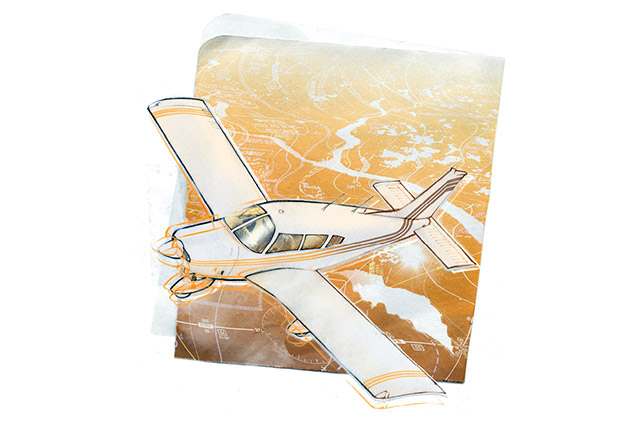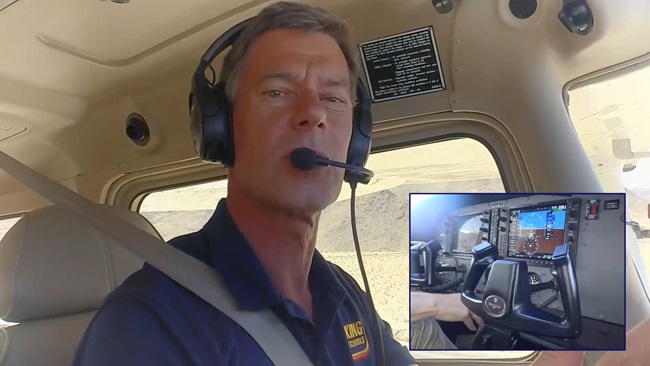 Finding the airport in haze and darkness
Finding the airport in haze and darkness
It was a typical north Florida late spring afternoon. My wife, our two children, and I had just departed Jacksonville after a perfect Mother’s Day with my mother, and we looked forward to the trip home.
The Piper Cherokee 180 climbed briskly in the humid evening sky. There was little chatter on the radio, but a Bonanza pilot who had just picked up an instrument clearance to Atlanta remarked how little visibility there was climbing through the haze. The brilliance of the setting sun, windshield crazing, and the haze caused me to rely solely on instruments during my climbout from Herlong Recreational Airport.
The little airplane was running flawlessly. I knew that once I reached cruising altitude, the little turbulence we were experiencing would abate and I could anticipate the smooth air that generally accompanied nightfall. The sun was setting in a blaze of orange and red, with the occasional glint of light reflecting off the swamp. I planned to switch on the autopilot, sit back, and enjoy the beauty of the setting sun, the smooth ride, and the persistent hum of the 180-horsepower Lycoming engine.
My 13-year-old son wanted to take the controls for a few minutes, so once we were level at cruise altitude, my young co-pilot took charge. The quickly descending nightfall did not seem to concern him, and he didn’t seem to want to give the controls over to the autopilot. The airplane was humming smoothly, and I could see a few lights below. I reached over and leaned the mixture, watched the exhaust gas temperature gauge settle down, and blam! The airplane began shaking violently and the engine made a banging sound much like the water hammer of an ancient boiler. Soon the airplane was shaking violently. I thought the engine might break loose from its mounts.
I pushed the mixture to full rich and pulled the throttle back to idle. The shaking stopped, but the quiet purr was gone and the sound was difficult to describe: a gentle knock with every revolution of the propeller. I checked the panel, oil pressure, fuel gauges, rpm, and fuel. The oil pressure was within the yellow arc. I increased the rpm again and the shaking began. We were in trouble.
The altimeter reflected 6,700 feet mean sea level. The wings were level, but I could feel the lightness in my seat that indicated a gradual descent. It was now almost dark and the lights on the horizon twinkled along with the stars above us. There was very little moonlight.
The panel was well lighted and the communications radio was set on the Jacksonville departure frequency. I knew we were somewhere between Folkston and Waycross, Georgia, over the worst of the swamp. Where could I land? I saw headlights on a long, straight road off my right wing and then suddenly the flash of an intermittent green light on the horizon.
I set up an 80-mph glide, attempted to reach Jacksonville Departure a couple of times, and finally switched to the universal emergency frequency of 121.5 MHz and declared, “Mayday, mayday, mayday.”
A controller responded to my distress call immediately and advised me that the Waycross airport was at 350 degrees and 12 miles. There was a hint of the sun settling below the horizon off the left wing, and I saw the beacon again about 10 or 15 degrees to my left. The airplane was gradually descending, and my heartbeat was increasing. Could I make it? We were at 6,000 feet msl.
The shaking had stopped and my family was looking at me for reassurance. My wife had given pillows to the children, and I had tightened my seatbelt. Remarkably, no one had panicked. The cockpit was quiet except for the occasional exchange with the controller. I called out 5,500 feet but had lost the beacon. How could I miss it, I thought. We were back in the haze and had very little visibility over the nose.
The controller said the airport was aware of our situation and had turned the runway lights to high intensity. A Piper Cub in the pattern was coming our way to help follow us in or be able to report our location quickly if we did not make the airport.
We were now at 3,000 feet agl, but I still could not see the airport. I checked my gyro against the compass and learned we were 15 degrees to the right of course. I reset the gyro and turned to 350 degrees, and suddenly I saw the beacon and the blue and white lights of the airfield. I didn’t think I could glide that far, so I told the controller I might need to land on a highway beneath me. He responded, “That will have to be your decision, sir.” We were four miles out at 3,000 feet.
“The airport’s at 12 o’clock, two miles.”
We might make it, I thought. The controller then remarked that we were beneath his radar coverage and ended his comments with “Good luck.” I pushed the rudder hard left and raised the nose a few degrees in order to line up with Runway 36. I then realized we were too high. I couldn’t go around, so I pushed the rudder to its stop, cranked in opposite aileron, and slipped the aircraft to the ground. We touched down in the grass just before the threshold of the runway, a little off the centerline. There was a moment of silence and then noisy relief. We climbed out of the airplane and hugged one another and thanked God for our safe landing.
It was determined upon teardown that the valves were improperly sized and failed, resulting in destruction of the engine. If there are lessons to be learned from a catastrophic engine failure, they include that one must always anticipate the potential of mechanical failure.
Michael W. Paul is an instrument- and multiengine-rated private pilot. He lives in Buford, Georgia.
Illustration by James Carey
Digital Extra Hear this and other original “Never Again” stories as podcasts every month on iTunes and download audio files free.


